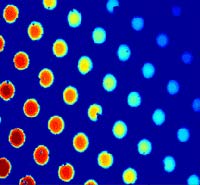Materials Sciences
Materials management deals with the research, development, manufacturing and processing of raw and industrial materials. Key aspects here are biological and medical issues, which play an increasingly important role in this field.
innovations-report offers in-depth articles related to the development and application of materials and the structure and properties of new materials.

Seamless circular ’nanorings’ could be nanoscale sensors, resonators & transducers
For nanoelectronics, biotechnology
An article to be published in the February 27 issue of the journal Science introduces “nanorings” as the newest member of a growing family of nanometer-scale structures based on single crystals of zinc oxide, a semiconducting and piezoelectric material that has important technological applications.
The rings, complete circles formed by a spontaneous self-coiling process, could serve as nanometer-scale sensors, resonators and transducers – a

Marine sponges provide model for nanoscale materials production
“Nature was nano before nano was cool,” stated Henry Fountain in a recent New York Times article on the proliferation of nanotechnology research projects. No one is more aware of this fact of nature than Dan Morse of the University of California, Santa Barbara. His research groups have been studying the ways that nature builds ocean organisms at the nanoscale for over ten years.
For example, they have studied the abalone shell for its high-performance, super-resistant, composite mineral str

Breakthroughs in capacity, power consumption set to revolutionize photonics
For years, organic electro-optic polymers have held the promise of vastly improving technologies such as communications, data processing and image displays. Now it appears scientists are on the verge of breakthroughs that will bring dramatic progress in materials, as well as the devices in which they are used, setting the stage for a virtual revolution.
Simply put, electro-optic polymers are being used to make devices that take information that typically has been transmitted electronically

Testing sticky stuff with a ’fly’s eye’
A new collaboration at the National Institute of Standards and Technology (NIST) will contend with lots of sticking points–by design. NIST and industry researchers intend to devise rapid screening and measurement methods that speed discovery of new epoxies, pressure-sensitive adhesives and other products manufactured for the $30 billion global adhesives market.
In a project just getting under way, the partners will refine and extend miniaturized technologies for simultaneous testing of hun

Controlling material structure at nanoscale makes better thermal insulator
Heat may be essential for life, but in some cases – such as protecting the space shuttle or improving the efficiency of a jet engine – materials with low thermal conductivities are needed to prevent passage of too much heat. As reported in the Feb. 13 issue of the journal Science, researchers have created a better thermal insulator by controlling material structure at the nanoscale.
“We explored ways to control thermal properties in materials by introducing structure on nanometer length scal

Etching of deep trenches in silicon explained
Dutch researcher Michiel Blauw has described the physical limitations of the plasma-etching of deep, narrow microstructures in silicon. His results have led to such an improvement in the etching process that trenches with a depth more than 30 times their width can now be made. This is important for the production of sensitive sensors.
Blauw investigated fluorine-based plasma etching processes. A plasma with a high ion-density ’burns’ a small hole in silicon. Many applications requi